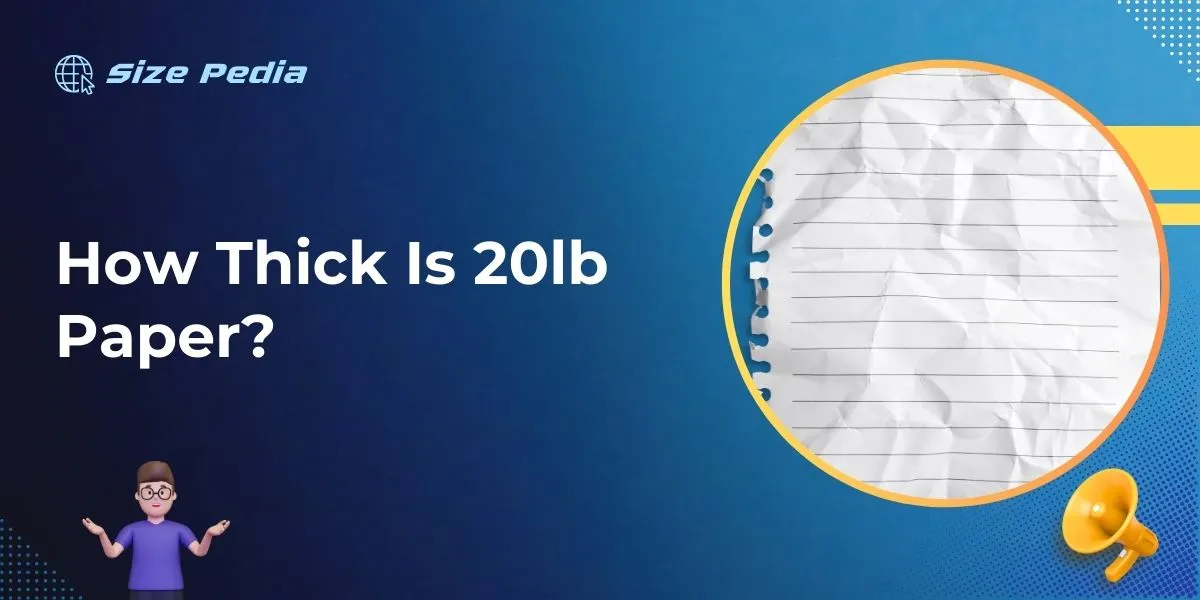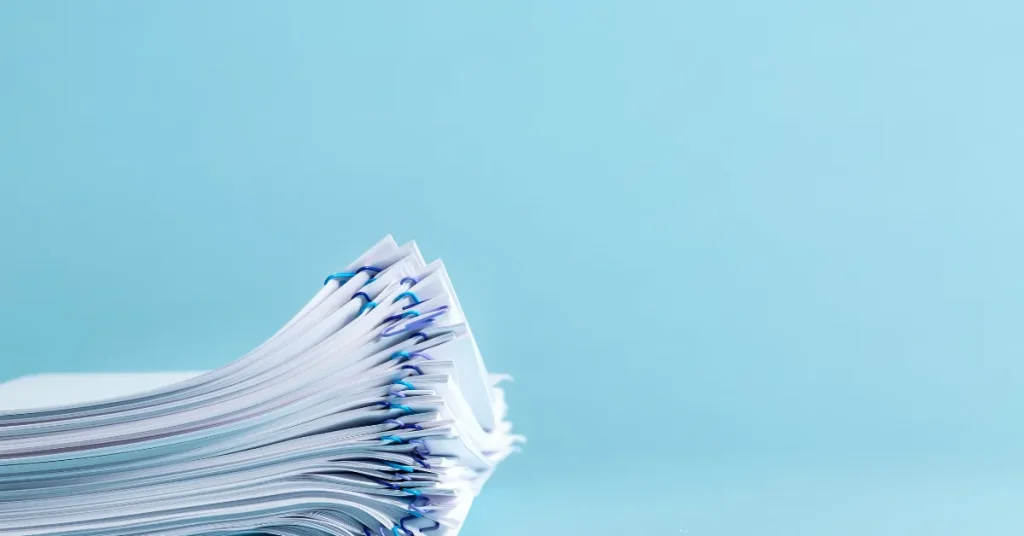20lb paper typically measures about 0.1 millimeters or 0.004 inches thick. This standard paper weight is common for everyday printing.
Exploring the characteristics of 20lb paper is key for anyone involved in printing, academic work, office duties, or creative projects. It is a versatile paper option, balancing durability with ease of handling, making it the quintessential choice for high-volume machines like photocopiers and desktop printers.
Understanding its thickness helps in determining suitability for various tasks, from crafting professional documents to creating flyers.
Opting for 20lb paper often reflects a preference for cost-effectiveness without sacrificing quality, as it performs well for both double-sided printing and various inkjet or laser printing jobs.
Its ubiquitous presence in the workplace showcases its practicality and reaffirms its status as a fundamental supply in everyday paper-related tasks.

The Basics Of Paper Weight
Understanding paper weight is essential. It affects choice for printing. Heavier paper adds durability. Lighter paper is more economical.
Defining Paper Pound Measurement
The term ‘lb’ or ‘pound’ measures paper density. It’s based on the weight of 500 sheets. This standard size is 17×22 inches for text paper, not always the common letter size. Higher numbers indicate thicker, heavier sheets.
Common Paper Stocks And Uses
Various projects need different paper types. Here’s a quick overview:
| Type of Paper | Weight | Common Uses |
| 20lb Paper | Lightweight | Everyday printing, copying |
| 24lb Paper | Midweight | Business letters, reports |
| 32lb Paper | Heavyweight | Premium documents, proposals |
| Cardstock | Extra Heavy | Postcards, business cards |
Choose the right paper weight. Consider printer compatibility. Think about the project’s purpose. Match paper to your needs.
20lb Paper In Context
Understanding the thickness of 20lb paper puts its versatility into perspective. ’20lb paper’ may evoke questions about its strength and applications. Let’s unfold this common paper weight and discover why it’s a go-to choice for both home and office needs.
Comparison With Other Paper Weights
20lb paper stands as the standard weight in most printers and copiers. To understand its place among various paper weights, consider the following:
- 16lb paper: lighter and often used for drafts and internal memos.
- 24lb paper: slightly thicker, giving a more professional feel; ideal for resumes and official documents.
- 32lb paper: high quality, very thick, typically reserved for presentations or important contracts.
These comparisons reveal that 20lb paper offers a balance between durability and cost efficiency.
Typical Applications Of 20lb Paper
The widespread use of 20lb paper stems from its practical balance of thickness and accessibility. Common uses include:
| Setting | Application |
| Home | Children’s homework, grocery lists |
| Office | Reports, daily printing, memos |
| School | Handouts, assignments, newsletters |
Each application highlights the paper’s adaptability and its efficacy in various printing tasks.
Measuring Paper Thickness

Understanding paper thickness is important. It affects how paper feels and works in printers. This holds true for 20lb paper, a common choice for everyday printing.
To really grasp the actual thickness, we dive into precise measurement methods. Interested in the nitty-gritty? Let’s explore how professionals measure it.
The Caliper Method
Calipers are precise tools that measure thickness. They press against the paper to record its size. Here’s how to use calipers to measure 20lb paper:
- Place the paper in the caliper.
- Gently close the caliper jaws on the paper.
- Read the measurement on the display. It’s usually in thousandths of an inch or millimeters.
Note: Always measure multiple sheets to get an average thickness.
Thickness Variability In Production
Paper thickness can vary, even in the same batch. A few factors cause this:
- Humidity and temperature changes.
- Different paper-making machines.
- Small variations in raw materials.
Finding the exact thickness of 20lb paper requires specific examples.
| Sample | Thickness (in thousandths of an inch) |
| 1 | 0.0038 |
| 2 | 0.0036 |
| 3 | 0.0039 |
Takeaway: Always check a few samples for consistent quality.
The Thickness Of 20lb Paper Revealed
Have you ever wondered how thick a standard sheet of 20lb paper is? This common paper weight fills our printers and copiers, but its thickness isn’t often discussed. Let’s dive into the specifics and uncover the details behind 20lb paper’s thickness.
Average Thickness
The average thickness of 20lb paper is roughly 0.097 mm. This measurement might seem thin, but it’s sturdy enough for day-to-day printing. To visualize, it’s thicker than a sheet of standard tissue but thinner than a cardboard.
| Paper Type | Thickness (mm) |
| 20lb Paper | 0.097 |
| Tissue Paper | < 0.097 |
| Cardboard | > 0.097 |
Factors Affecting Thickness
Not all 20lb papers are exactly the same. Different factors can change how thick it feels. These factors include:
- Moisture content: In humid conditions, paper can absorb water and swell.
- Manufacturing process: How the paper is pressed and treated can alter its density.
- Material: The source of the paper, like recycled fibers, can affect thickness.
Remember, 20lb paper refers to the weight of a ream, not the thickness of a single sheet. So it’s best to check with manufacturers for the exact thickness.
Importance Of Understanding Paper Thickness

Choosing the right paper for printing or art projects is crucial. It’s not just the color and texture that matter. Paper thickness, known as weight, affects both appearance and practicality.
For those who aren’t experts in stationery, 20lb paper is a common option. But understanding what that means in terms of thickness helps to ensure the best result for your project.
Impact On Printing And Copying
Thicker paper often means better quality. But it can also cause issues with standard printers. Heavy paper might jam or print poorly on machines built for lighter weights.
Knowing that 20lb paper is a standard weight helps to prevent printer mishaps. It’s thin enough to avoid jams in most machines, but thick enough for documents to feel substantial. Let’s look at the common impacts:
- Jamming: Too thick can lead to print jams.
- Ink drying: Thicker paper absorbs ink differently.
- Cost: Thicker paper often costs more to print on.
Choosing The Right Paper For Your Project
Picking the ideal paper weight is crucial for both the final feel and look. For professional documents, 20lb paper provides durability without the excess bulk.
For personal projects, understanding the feel of this weight can help you decide if it’s the right choice for, say, wedding invitations. Here’s a guide to help you:
| Paper Type | Weight | Best for |
| 20lb Paper | Standard Thickness | Daily printing and copying |
| 24lb Paper | Slightly Thicker | Business documents |
| 32lb Paper | Thick | Professional presentations |
Identifying the correct paper type saves time and elevates the quality of your work. For most everyday tasks, 20lb paper strikes the just-right balance between quality and ease of use.
FAQs About How Thick Is 20lb Paper
Is 20 Lb Paper Thick?
20 lb paper is considered standard thickness for everyday printing and writing tasks. It’s not particularly thick; rather, it’s comparable to regular office paper.
Is 22 Lb Paper Thick?
Yes, 22 lb paper is relatively thick, often used for professional documents and presentations for added durability and a quality feel.
Is 28 Lb Paper Thick?
Yes, 28 lb paper is thicker than standard copy paper, providing a more substantial feel. It’s ideal for professional documents and presentations.
How Thick Is 18 Pound Paper?
18 pound paper typically has a thickness of about 0. 0037 inches (3. 7 thousandths of an inch or about 94 micrometers).
Conclusion
Understanding the thickness of 20lb paper is crucial for your printing needs. From crafting to office use, it’s a versatile choice.
This knowledge helps in making informed decisions, ensuring your projects turn out perfectly. Remember, the right paper thickness can make all the difference.
Choose wisely and print confidently!
Resources:
1. https://resources.cs.rutgers.edu/docs/paper-size/
